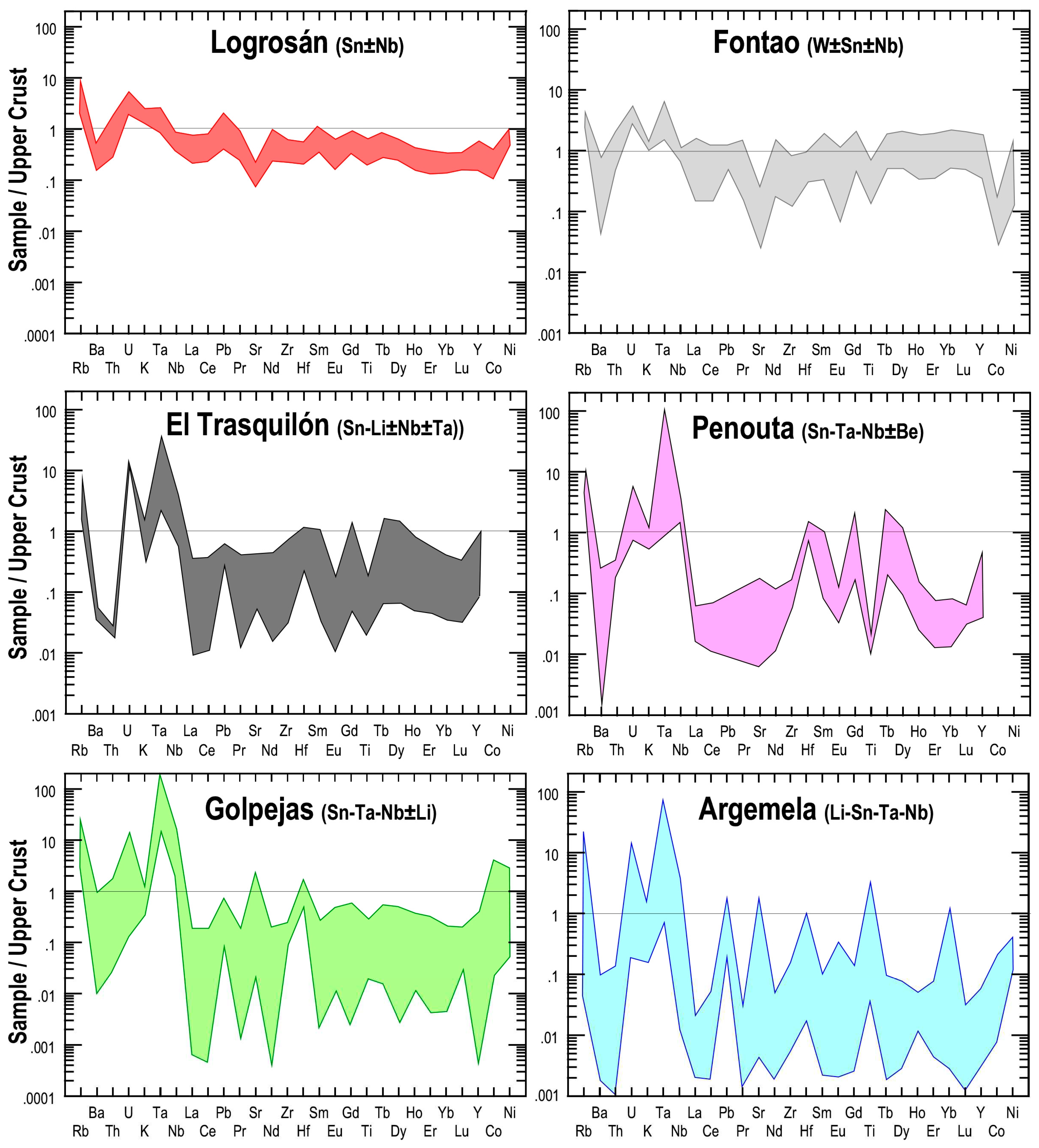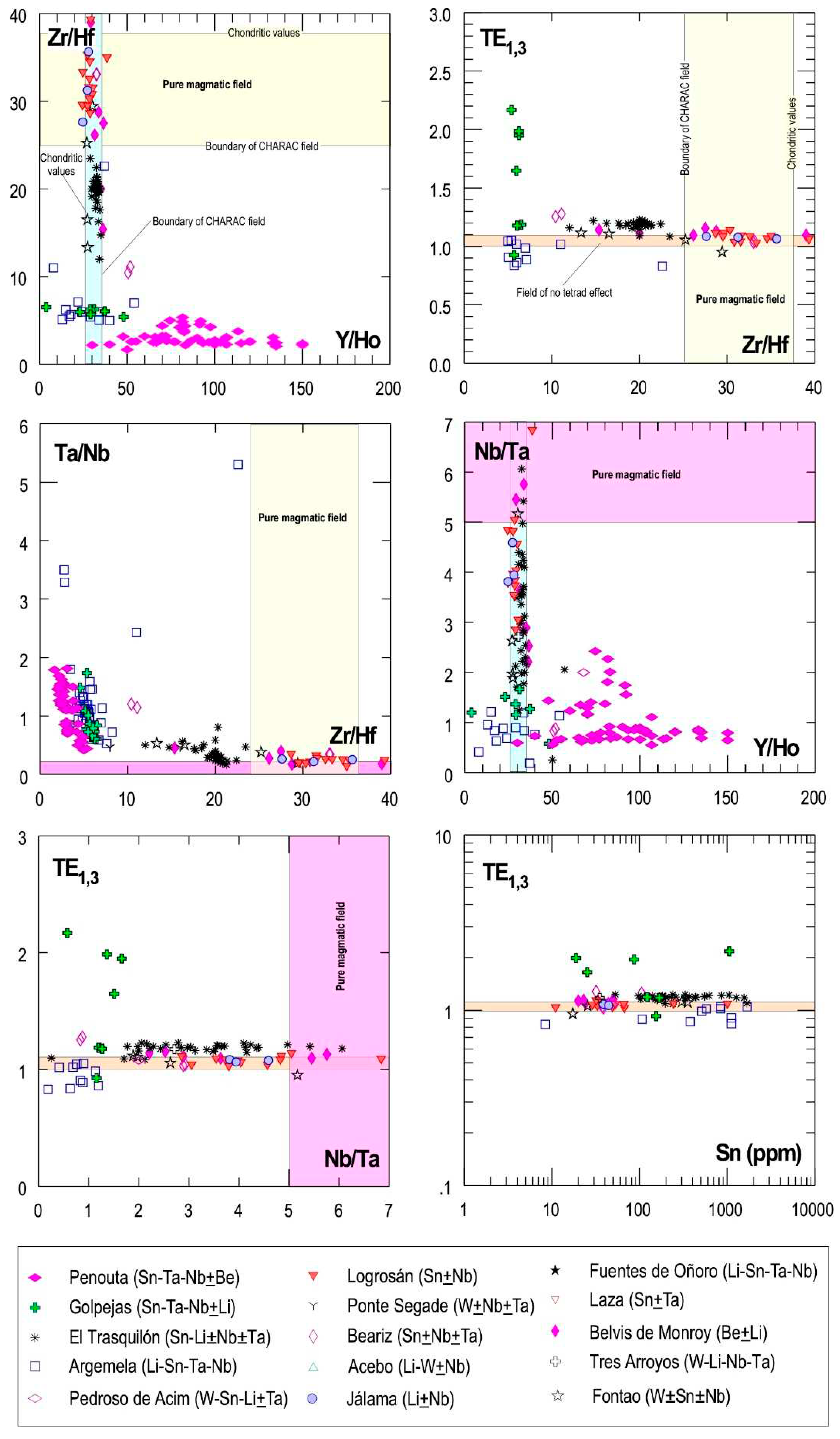Submitted:
02 January 2024
Posted:
03 January 2024
You are already at the latest version
Abstract
Keywords:
1. Introduction
2. Geological Setting
3. Occurrences of Rare Metal Granites in the Central Iberian Zone and Data Sources
| Occurrence | Granite type | Mineralization | Maximum ore content (ppm) | Reserves (Mt) | Whole rockΔ source | Mineral chemistry source |
|---|---|---|---|---|---|---|
| Penouta | AG/LP/NbTa-rich | Sn-Ta-Nb±Be | Sn: 3800; Ta: 226 | >10 | [2,37] | [3,4,38] |
| Golpejas | AG/HP/NbTa-rich | Sn-Ta-Nb±Li | Sn: 2097; Ta: 215 | 5-10 | [38,39] | This work |
| Argemela | AG/HP/NbTa-rich | Li-Sn-Ta-Nb | Sn: 1960; Ta: 161 | Unknown | [5,20,40] | [5,20] |
| Villardeciervos | AG/NbTa-rich | Sn-Nb-Ta | Sn: 439; Ta: 273 | 1-5 | [41,42] | - |
| Fuentes de Oñoro | AG/MP/NbTa-rich | Li-Sn-Ta-Nb | Sn: 500*; Ta: 50* | <1 | [43] | - |
| Tres Arroyos | LG/MP/NbTa-rich | W-Li-Nb-Ta | Sn: 781; Ta: 124 | <1 | [44,45] | [44] |
| El Trasquilón | AG/HP/NbTa-poor | Sn-Li±Nb±Ta | Sn: 5830; Ta: 78 | 1-5 | [38,44,46] | [44] |
| Fontao | 2M/MP/NbTa-poor | W±Sn±Nb | W: 266; Ta: 13 | 1-5 | [38] | - |
| Logrosán | LG/MP/NbTa-poor | Sn±Nb | Sn: 1000; Ta: 5.7 | <1 | [35,47] | [35,47] |
| Laza | LG/NbTa-poor | Sn±Ta | Sn: 2300; Ta: 10 | 5-10 | [48] | - |
| Ponte Segade | AG/MP/NbTa-poor | W±Nb±Ta | Sn: 110; Ta: 7 | <1 | [49] | [49] |
| Beariz | LG/MP/NbTa-poor | Sn±Nb±Ta | Sn: 105; Ta: 45 | <1 | [50] | [50] |
| Acebo | 2M/NbTa-poor | Li-W±Nb | Sn: 60; Ta: 40 | 1-5 | [51] | - |
| Torrecilla | 2M/NbTa-poor | Sn-W±Li | Sn: 7200; Ta: - | 1-5 | [51] | - |
| Belvis de Monroy | LG/MP/NbTa-poor | Be±Li | Sn: 50; Ta: 5 | Unknown | [52] | - |
| Pedroso de Acim | 2M/MP/NbTa-poor | W-Sn-Li±Nb±Ta | Sn: 602; Ta: 29 | <1 | [44,51,53] | - |
| Jálama | 2M/MP/NbTa-poor | Li±Nb | Sn: 44; Ta: 7 | Unknown | [54] | - |
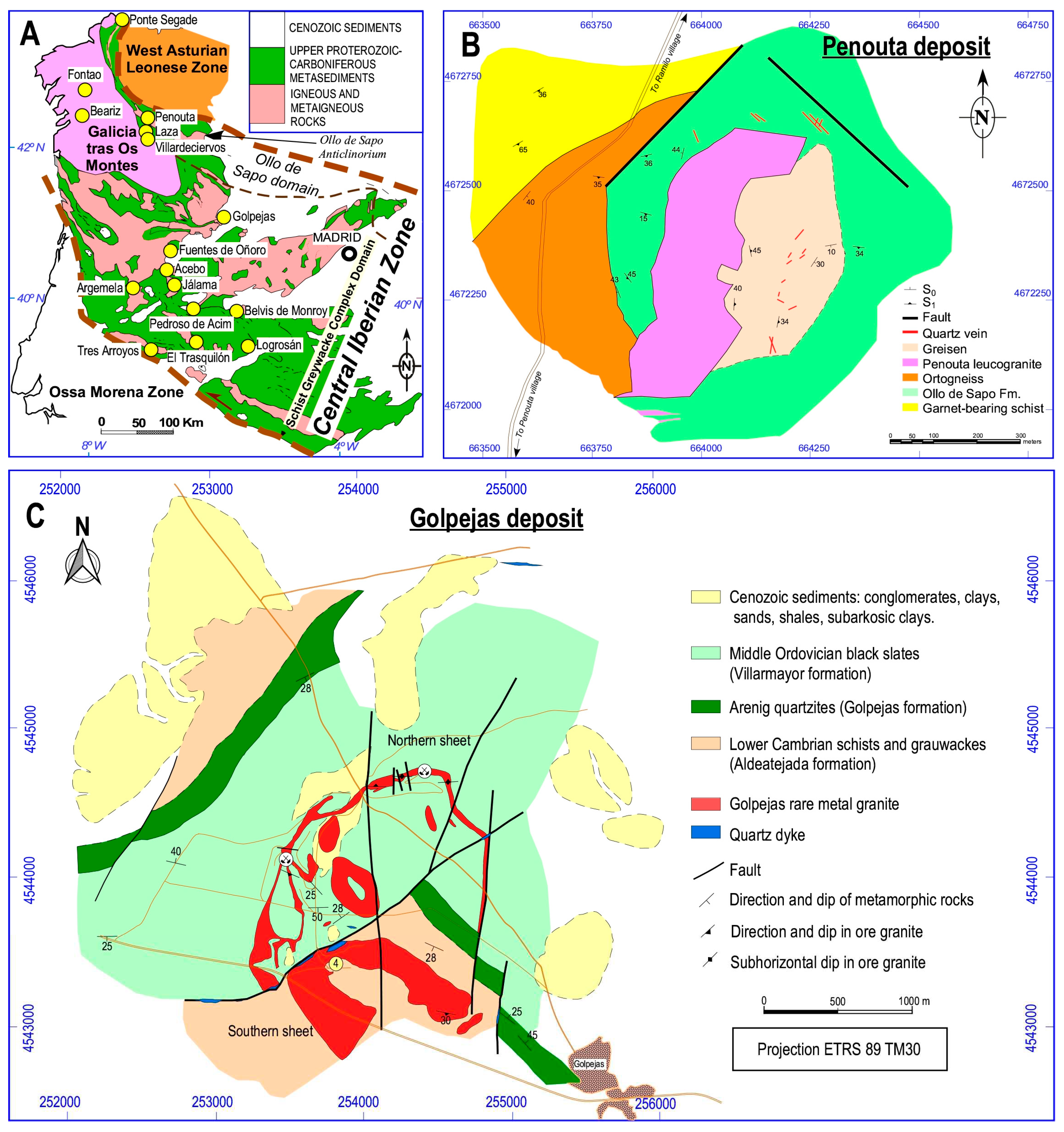
3.1. The Penouta Sn-Ta-Nb±Be Albite Granite
3.2. The Golpejas Sn-Ta-Nb±Li Albite Granite
4. Methods
4.1. Mineral Chemistry
4.2. Geothermobarometry
4.3. Water Content
4.4. Numerical Modeling
5. Results
5.1. Mineral Chemistry
5.1.1. White Mica
5.1.2. Alkali Feldspars
5.1.3. Columbite Group Minerals
5.2. Whole Rock Geochemistry
5.2.1. Major Element Compositions
5.2.2. Trace Element and REE Concentrations
5.2.3. Isovalent Trace Element Ratios and Lanthanide Tetrad Effect (TE1,3)

5.2.4. Isotope Geochemistry
5.2.4. Geochronology
5.3. Geothermobarometry
5.4. Water Content
6. Discussion
6.1. The Parental Magmas of Iberian rare Metal Granites
6.2. Chemical Evolution in Iberian RMGs
6.3. The Role of Fluids in the Crystallization of Iberian RMGs
6.4. Ore Formation in Iberian RMGs
6.4.1. Sn-Nb-Ta-Rich Granites

6.4.2. Nb-Ta-Poor Granites
7. Conclusions
- (1)
- The Iberian rare metal granites can be divided into Nb-Ta-rich and Nb-Ta-poor granites in view of their contrasting intensive variables and geochemistry.
- (2)
- The low emplacement pressure and the large amount of water in the Nb-Ta-rich melts allow the fractionation of twin pairs (Zr-Hf, Y/Ho and Nb/Ta) together with saturation and exsolution processes of the volatile phase, which are manifested in snowball quartz textures, white mica-rich layers (especially in the margins), aplopegmatites intercalated in the granite (especially in the apical zone), metasomatic processes (albitization), greisen formation and P loss in the feldspars (especially in the plagioclase).
- (3)
- The parental magmas of the Iberian GMRs can be very diverse, mainly two-mica granites and granites with cordierite, although granodiorites and type I granites could be the parental magmas of the P-poor GMRs.
- (4)
- Thermodynamic modeling shows that the high Al and P contents of Nb-Ta rich granites can be explained by melt evolution. This does not occur with the strong Na enrichment of the RMGs and the presence of fluxing elements, albitization or non-equilibrium crystallization processes must be involved.
- (5)
- The samples that best fit the thermodynamic evolution are the aplitic rim facies of the Argemela granite, probably because of their rapid crystallization, which avoided much interaction with the volatile phase and/or fluxing elements.
- (6)
- The absence of inflections in the variation diagrams with Nb and Ta, the high solubility of CGMs in melts rich in fluxing elements, as well as the good fit in two-step models (with major and trace elements) involving white mica, suggest that this mineral played a very relevant role in the evolution of Ta and Ta/Nb in RMGs.
Supplementary Materials
Author Contributions
Funding
Acknowledgments
Conflicts of Interest
References
- López-Moro, F.J.; Díez-Montes, A.; Llorens-González, T.; Sánchez-García,T.; Timón-Sánchez, S.M. Is the kaolinization process the key to explaining the enrichment of critical metals in the apical zones of rare-metal granites?. In Goldschmidt 2023, Lyon, France, 10-07-2023.
- López-Moro, F.J.; García Polonio, F.; Llorens González, T.; Sanz Contreras, J.L.; Fernández Fernández, A.; Moro Benito, M.C. Ta and Sn concentration by muscovite fractionation and degassing in a lens-like granite body: The case study of the Penouta rare-metal albite granite (NW Spain). Ore Geol. Rev. 2017, 82, 10–30. [Google Scholar] [CrossRef]
- Llorens, T.; García Polonio, F.; López Moro, F.J.; Fernández, A.; Sanz, J.L.; Moro, M.C. Tin-tantalum-niobium mineralization in the Penouta deposit (NW Spain): Textural features and mineral chemistry to unravel the genesis and evolution of cassiterite and columbite group minerals in a peraluminous system. Ore Geol. Rev. 2017, 81, 79–95. [Google Scholar] [CrossRef]
- Alfonso, P.; Hamid, S.A.; García-Valles, M.; Llorens, T.; López-Moro, F.J.; Tomasa, O.; Calvo, D.; Guasch, E.; Anticoi, H.; Oliva, J.; Parcerisa, D.; García Polonio, F. Textural and mineral-chemistry constraints regarding the columbite-group minerals in the Penouta deposit: evidences of magmatic and fluid-related processes. Min. Mag. 2018, 82, S199–S222. [Google Scholar] [CrossRef]
- Michaud, J.A.S.; Pichavant, M. Magmatic fractionation and the magmatic-hydrothermal transition in rare metal granites: Evidence from Argemela (Central Portugal). Geochim. Cosmochim. Acta 2020, 289, 130–157. [Google Scholar] [CrossRef]
- Wolf, M.; Romer, R.L.; Franz, L.; López-Moro, F.J. Tin in granitic melts: The role of melting temperature and protolith composition. Lithos 2018, 310–311, 20–30. [Google Scholar] [CrossRef]
- Matte, P. Accretionary history and crustal evolution of the Variscan belt in Western Europe. Tectonophysics 1991, 196, 309–337. [Google Scholar] [CrossRef]
- Sánchez Martínez, S.; Arenas, R.; García, F.D.; Martínez-Catalán, J.R.; Gómez-Barreiro, J.; Pearce, J.A. Careón ophiolite, NW Spain: Suprasubduction zone setting for the youngest Rheic Ocean floor. Geology, 2007, 35, 53–56. [Google Scholar] [CrossRef]
- Escuder Viruete, J.; Arenas, R.; Martínez-Catalán, J.R. Tectonothermal evolution associated with Variscan crustal extension in the Tormes Gneiss Dome (NW Salamanca, Iberian Massif, Spain). Tectonophysics 1994, 238, 117–138. [Google Scholar] [CrossRef]
- Gapais, D.; Lagarde, J.L.; Le Corre, C.; Audren, C.; Jégouzo, P.; Casas Saintz, A.; Van Den Driessche, J. La zone de cisaillement de Quiberon : témoin d’extension de la chaîne varisque en Bretagne méridionale au Carbonifère. CR Acad Sci II A 1993, 316, 1123–1129. [Google Scholar]
- Gapais, D.; Brun, J.P.; Gumiaux, C.; Cagnard, F.; Ruffet, G.; Veslud, C.L.C.D. Extensional tectonics in the Hercynian Armorican belt (France). An overview. BSGF 2015, 186, 117–129. [Google Scholar] [CrossRef]
- Matte, P. La chaine varisque parmi les chaines paleozoiques peri atlantiques, modele d’evolution et position des grands blocs continentaux au Permo-Carbonifere. BSGF 1986, II, 9–24. [Google Scholar] [CrossRef]
- Faure, M. Late orogenic carboniferous extensions in the Variscan French Massif Central. Tectonics 1995, 14, 132–153. [Google Scholar] [CrossRef]
- Faure, M.; Bé Mézèmé, E.; Duguet, M.; Cartier, C.; Talbot, J.Y. Paleozoic tectonic evolution of medio-europa from the example of the french massif central and massif armoricain. J Virtual Explor Electron Edit 2005, 19, 1–26. [Google Scholar] [CrossRef]
- Michaud, J.A. Rare metal granites origin, emplacement and mechanisms of the magmatic-hydrothermal transition - Insights from the Argemela Rare Metal Granite (Portugal) and an experimental study. PhD Thesis Univ. D’Orléans, 2019.
- Chauris, L. Les leucogranites à béryl de Bretagne méridionale. 113e Congrès National des Sociétés Savante, Strasbourg, Sciences de la Terre, 1988, pp. 37-49.
- Raimbault, L. Composition of complex lepidolite-type granitic pegmatites and of constituent columbite-tantalite, Chedeville, Massif Central, France. Can. Mineral. 1998, 36, 563–583. [Google Scholar]
- Raimbault, L.; Charoy, B.; Cuney, M.; Pollard, P.J. Comparative geochemistry of Ta-bearing granites. In Source, Transport and Deposition of Metals; Pagel, M., Leroy, J.L., Eds.; Society for Geology Applied to Mineral Deposits, 1991; pp.793-796.
- Aubert, G. Les coupoles granitiques de Montebras et d’Échassières:(Massif Central français) et la genèse de leurs minéralisations en étain, lithium, tungstène et béryllium. Éditions BRGM, 1969.
- Breiter, K.; Durisová, J.; Korbelová, Z.; Lima, A.; Vasinová Galiová, M.; Hlozková, M.; Dosbaba, M. Rock textures and mineral zoning – A clue to understanding rare-metal granite evolution: Argemela stock, Central-Eastern Portugal. Lithos 2022, 410-411, 106562. [Google Scholar] [CrossRef]
- Breiter, K.; Müller, A.; Leichmann, J.; Gabašová, A. Textural and chemical evolution of a fractionated granitic system: the Podlesí stock, Czech Republic. Lithos 2005, 80, 323–345. [Google Scholar] [CrossRef]
- Breiter, K.; Ďurišová, J.; Hrstka, T.; Korbelová, Z.; Vaňková, M.H.; Galiová, M.V.; Kanický, V.; Rambousek, P.; Knésl, I.; Dobeš, P.; Dosbaba, M. Assessment of magmatic vs. metasomatic processes in rare-metal granites: a case study of the Cínovec/Zinnwald Sn–W–Li deposit, Central Europe. Lithos 2017, 292, 198–217. [Google Scholar] [CrossRef]
- Manning, D.A.C.; Hill, P.I. The petrogenetic and metallogenetic significance of topaz granite from the Southwest England orefield. Geol. S. Am. S. 1990, 246, 51–69. [Google Scholar]
- Müller, A.; Seltmann, R.; Halls, C.; Siebel, W.; Dulski, P.; Jeffries, T.; Spratt, J.; Kronz, A. The magmatic evolution of the Land’s End pluton, Cornwall, and associated pre-enrichment of metals. Ore Geol. Revs. 2006, 28, 329–367. [Google Scholar] [CrossRef]
- Eby, G.N. The A-type granitoids: a review of their occurrence and chemical characteristics and speculations on their petrogenesis. Lithos 1990, 26, 115–134. [Google Scholar] [CrossRef]
- Díez-Montes, A.; Martínez Catalán, J.R.; Bellido Mulas, F. Role of the Ollo de Sapo masive felsic volcanism of NW Iberia in the Early Ordovician dynamics of northern Gondwana. Gondwana Res. 2010, 17, 363–376. [Google Scholar] [CrossRef]
- Rodríguez-Alonso, M.D.; Peinado, M.; López-Plaza, M.; Franco, P.; Carnicero, A.; Gonzalo, J.C. Neoproterozoic-Cambrian synsedimentary magmatism in the Central Iberian Zone (Spain): geology, petrology and geodynamic significance. Int. J. Earth Sci. 2004, 93, 897–920. [Google Scholar] [CrossRef]
- Arenas, R.; Martínez-Catalán, J.R., Díaz García, F. Zona de Galicia-Trás-os-Montes. In Geología de España; Vera Torres, J.A., Ed.; Sociedad Geológica de España e Instituto Geológico y Minero de España. pp. 133-165.
- Dallmeyer, R.D.; Martínez Catalán, J.R.; Arenas, R.; Gil Iberguchi, J.I.; Gutiérrez Alonso, G.; Farias, P.; Bastida, F.; Aller, J. Diachronous Variscan tectonothermal activity in the NW Iberian Massif: Evidence from 40Ar/39Ar dating of regional fabrics. Tectonophysics, 1997, 277, 307-337.
- Valverde-Vaquero, P.; Díez-Balda, M.A.; Díez-Montes, A.; Dörr, W.; Escuder-Viruete, J.; González-Clavijo, E.; Maluski, H.; Rodríguez-Fernández, L.R.; Rubio, F.; Villar, P. The ‘‘Hot Orogen’’: Two Separate Variscan Low-Pressure Metamorphic Events in the Central Iberian Zone (Abstract 76). Mechanics of Variscan Orogeny: A Modern View on Orogenic Research. Geol France 2. BRGM, 2007.
- Valle Aguado, B.; Azevedo, M.R.; Schaltegger, U.; Martínez Catalán, J.R.; Nolan, J. U/Pb zircon and monazite geochronology of Variscan magmatism related to synconvergence extension in Central Northern Portugal. Lithos 2005, 82, 169–184. [Google Scholar] [CrossRef]
- López-Moro, F.J.; López-Plaza, M.; Romer, R.L. Generation and emplacement of shear-related highly mobile crustal melts: the synkinematic leucogranites from the Variscan Tormes Dome, Western Spain. Int. J. Earth Sci. 2012, 101, 1273–1298. [Google Scholar] [CrossRef]
- Gutiérrez-Alonso, G.; Collins, A.S.; Fernández-Suárez, J.; Pastor-Galán, D.; González-Clavijo, E.; Jourdan, F.; Weil, A.B.; Johnston, S.T. Dating of lithospheric buckling: 40At/39Ar ages of syn-orocline strike-slip shear zones in northwestern Iberia. Tectonophysics 2015, 643, 44–54. [Google Scholar] [CrossRef]
- Arribas, A.; Gonzalo Corral, F.J. , Iglesias, M. Génesis de una mineralización asociada a una cúpula granítica: el yacimiento de estaño de Golpejas, (Salamanca). Cadernos do Laboratorio Xeolóxico de Laxe 1982, 3, 563–592. [Google Scholar]
- Chicharro, E. Petrologic-metallogenic characterization of a specialized granite: the Logrosán stock (Cáceres). Ph Thesis, Universidad Complutense de Madrid, Madrid, 2016.
- Gonzalo Corral, F.J. , Gracia Plaza, A.S. Yacimientos de estaño del Oeste de España. Cadernos do Laboratorio Xeolóxico de Laxe 1985, 9, 265–303. [Google Scholar]
- ADARO. Penouta deposit mining research. Volume I. Geological characteristics and reserves. Final Report, 1985, pp. 1-123 (In Spanish).
- Reginiussen, H.; Jonsson, E.; Hamisi, J.; Timón-Sánchez, S.M.; Díez-Montes, A.; Teran, K.; Salgueiro, R.; Oliveira, D.; Melnik, I. Providing data and intelligence on Nb-Ta mineralizations in Europe to the GeoERA information platform. FRAME WP6, D6.4. 26p. Appendix 1. Analytical data Spanish deposits. 220p, 2021.
- Solid Mines España. Alberta 5 Golpejas-Salamanca tin-tantalum project. Internal report, 2005.
- Charoy, B.; Norohna, F. Multistage Growth of a Rare-Element Volatile-Rich Microgranite at Argemela (Portugal). J. Petrol. 1996, 37, 73–74. [Google Scholar] [CrossRef]
- Armstrong, E.; Murillo, A.; Pages, J.L. Investigación minera por estaño en la reserva nº 146 “Villardeciervos” (Orense). Cadernos do Laboratorio Xeolóxico de Laxe 1983, 6, 459–467. [Google Scholar]
- ITGE. Estimation of the mining potential in the area of Villardevós (ORENSE). Annex 1, Methodology and content sheets, final report, 1976 (in Spanish).
- López-Plaza, M.; Rodríguez Alonso, M.D.; Martín Herrero, D.; Albert Colomert, V. Mapa Geológico y Memoria de la Hoja nº 525 (Ciudad Rodrigo), 2ª serie del Mapa Geológico Nacional a escala 1:50.000 (MAGNA). Servicio de Publicaciones IGME, Madrid. 1990, 1-96.
- Gallego Garrido, M. Las mineralizaciones de litio asociadas a magmatismo ácido en Extremadura y su encuadre en la zona Centro-Ibérica. Ph Thesis, Universidad Complutense de Madrid, Madrid, 1992.
- Garate-Olave, I.; Roda-Robles, E.; Gil-Crespo, P.P.; Pesquera, A.; Errandonea-Martin, J. The Tres Arroyos granitic aplite-pegmatite field (Central Iberian Zone, Spain): petrogenetic constraints from evolution of Nb-Ta-Sn oxides, whole-rock geochemistry and U-Pb geochronology. Minerals 2020, 10, 1008. [Google Scholar] [CrossRef]
- IGME (1980). Project: Expansion of the intermediate phase of Sn-W mining research in several areas of Extremadura. El Trasquilón area, final report, 1980, (in Spanish).
- Chicharro, E.; Martín-Crespo, T.; Gómez-Ortiz, D.; López-García, J.A.; Oyarzun, R.; Villaseca, C. Geology and gravity modeling of the Logrosán Sn–(W) ore deposits (Central Iberian Zone, Spain). Ore Geol. Rev. 2015, 65, 294–307. [Google Scholar] [CrossRef]
- ITGE. Basic Study of Tin Deposits. Type-Laza. Memory-annexes and maps, final report, 1976, pp.1-149, (in Spanish).
- Canosa, F.; Martin-Izard, A.; Fuertes-Fuente, M. Evolved granitic systems as a source of rare-element deposits: The Ponte Segade case (Galicia, NW Spain). Lithos 2012, 153, 165–176. [Google Scholar] [CrossRef]
- Gloaguen, E. Apports d’une étude intégrée su les relations entre granites et minéralisations filoniennes (Au et Sn-W) en contexte tardi orogénique (Chaîne Hercynienne, Galice centrale, Espagne). Ph Thesis, University of D’Orleans, 2006.
- González Aguado, M.T. Mineralizaciones de Sn-Nb-Ta asociadas a cúpulas graníticas de Extremadura. Ph Thesis, Escuela Técnica Superior de Ingenieros de Minas, Madrid, 1985.
- Merino, E.; Villaseca, C.; Orejana, D.; Jeffries, T. Gahnite, chrysoberyl and beryl co-occurrence as accessory minerals in a highly evolved peraluminous pluton: The Belvís de Monroy leucogranite (Cáceres, Spain). Lithos 2013, 179, 137–156. [Google Scholar] [CrossRef]
- ADARO. Research Project for tin and wolfram on the permit “MARIVI” Pedroso de Acim (Cáceres). Volume 1. Final Report, 1984, pp. 1-215 (In Spanish).
- Ramírez, J.A.; Grundvig, S. Causes of geochemical diversity in peraluminous granitic plutons: the Jálama pluton, Central-Iberian Zone (Spain and Portugal). Lithos 2000, 50, 171–190. [Google Scholar] [CrossRef]
- Minera del Duero. Mining work Mina Bellita and Tita (Golpejas): Final report, 1985 (In Spanish).
- Díez-Montes, A. La geología del Dominio “Ollo de Sapo” en las comarcas de Sanabria y Terra do Bolo. Serie NOVA TERRA 34, A Coruña, 2007.
- Watson, E.B.; Harrison, T.M. Zircon saturation revisited: temperature and compositional effects in a variety of crustal magma types. Earth Planet. Sci. Lett. 1983, 64, 295–304. [Google Scholar] [CrossRef]
- Montel, J.M. A model for monazite/melt equilibrium and application to the generation of granitic magmas. Chem. Geol. 1993, 110, 127–146. [Google Scholar] [CrossRef]
- Pichavant, M.; Montel, J.M.; Richard, L.R. Apatite solubility in peraluminous liquids: Experimental data and an extension of the Harrison-Watson model. Geochim. Cosmochim. Acta 1992, 56, 3855–3861. [Google Scholar] [CrossRef]
- Massonne, H.J.; Schreyer, W. Phengite geobarometry based on the limiting assemblage with k-feldspar, phlogopite, and quartz. Contrib. Mineral. Petrol. 1987, 96, 212–224. [Google Scholar] [CrossRef]
- Moore, G.; Vennemann, T.; Carmichael, I.S.E. An empirical model for the solubility of H2O in magmas to 3 kilobars. Am. Mineral. 1998, 83, 36–42. [Google Scholar] [CrossRef]
- Gualda, G.A.R.; Ghiorso, M.S.; Lemons, R.V.; Carley, T. Rhyolite-MELTS: a Modified Calibration of MELTS Optimized for Silica-rich, Fluid-bearing Magmatic Systems. J. Petrol. 2012, 53, 875–890. [Google Scholar] [CrossRef]
- Cabero, M.T.; Mecoleta, S.; López-Moro, F.J. OPTIMASBA: a Microsoft Excel workbook to optimise the mass-balance modelling applied to magmatic differentiation processes and subsolidus overprints. Comput. Geosci. 2012, 42, 206–211. [Google Scholar] [CrossRef]
- Ersoy, E.Y.; Helvaci, C. FC–AFC–FCA and mixing modeler: A Microsoft® Excel© spreadsheet program for modeling geochemical differentiation of magma by crystal fractionation, crustal assimilation and mixing. Comput. Geosci. 2010, 36, 383–390. [Google Scholar] [CrossRef]
- Tischendorf, G.; Gottesmann, B.; Förster, H.-J.; Trumbull, R.B. On Li-bearing micas: estimating Li from electron microprobe analyses and an improved diagram for graphical representation. Min. Mag. 1997, 61, 809–834. [Google Scholar] [CrossRef]
- Van Lichtervelde, M.; Holtz, F.; Melcher, F. The effect of disequilibrium crystallization on Nb-Ta fractionation in pegmatites: Constraints from crystallization experiments of tantalite-tapiolite. Am. Min. 2018, 103, 1401–1416. [Google Scholar] [CrossRef]
- London, D. Phosphorus in S-type magmas: The P2O5 content of feldspars from peraluminous granites, pegmatites, and rhyolites. Am. Mineral. 1992, 77, 126–145. [Google Scholar]
- London, D.; Morgan VI, G.B.; Babb, H.A.; Loomis, J.L. Behavior and effects of phosphorus in the system Na2O-K2O-Al2O3-SiO2-P2O5-H2O at 200 MPa (H2O). Contrib. Mineral. Petrol. 1993, 113, 450–465. [Google Scholar] [CrossRef]
- Linnen, R.L. The effects of water on the solubility of accessory minerals in granitic melts. Lithos 2005, 80, 267–280. [Google Scholar] [CrossRef]
- Linnen, R.L.; Keppler, H. Columbite solubility in granitic melts: Consequences for the enrichment and fractionation of Nb and Ta in the Earth’s crust. Contrib. Mineral. Petrol 1997, 128, 213–227. [Google Scholar] [CrossRef]
- Linnen, R.L.; Cuney, M. Granite-related rare-element deposits and experimental constraints on Ta-Nb-W-Sn-Zr-Hf mineralization. In Rare-Element Geochemistry and Mineral Deposits; Linnen, R.L., Samson, I.M., Eds.; Geological Association of Canada, GAC Short Course Notes; 2005, 17, pp. 45-67.
- Tang, Y.; Zhang, H.; Rao, B. The effect of phosphorus on manganocolumbite and mangaotantalite solubility in peralkaline to peraluminous granitic melts. Am. Mineral. 2016, 101, 415–422. [Google Scholar] [CrossRef]
- Frost, B.R.; Frost, C.D. . A geochemical classification for feldspathic igneous rocks. J. Petrol. 2008, 49, 1955–1969. [Google Scholar] [CrossRef]
- Frost, B.R.; Barnes, C.G.; Collins, W.J.; Arculus, R.J.; Ellis, D.J.; Frost, C.D. A geochemical classification for granitic rocks. J. Petrol. 2001, 42, 2033–2048. [Google Scholar] [CrossRef]
- Pearce. J.A.; Harris, N.B.W.; Tindle. A.G. Trace element discrimination diagrams for the tectonic interpretation of granitic rocks. J. Petrol. 1984, 25, 956–983. [Google Scholar] [CrossRef]
- Maniar, P.D.; Piccoli, P.M. Tectonic discrimination of granitoids. Geol. Soc. Am. Bull. 1989, 101, 635–643. [Google Scholar] [CrossRef]
- Debon, F.; Le Fort, P. A chemical mineralogical classification of common plutonic rocks and association. Earth Sci. 1983, 73, 135–149. [Google Scholar] [CrossRef]
- Villaseca, C.; Barbero, L.; Herreros, V. . A re-examination of the typology of peraluminous granite types in intracontinental orogenic belts. T. RSE. Earth 1998, 89, 113–119. [Google Scholar] [CrossRef]
- Le Maitre, R.W.; Bateman, P.; Dudek, A.; Keller, J.; Lameyre, J.; Le Bas, M.J.; Sabine, P.A.; Schmid, R.; Sorensen, H.; Streckeisen, A.; Woolley, A.R.; Zanettin, B. A classification of igneous rocks and glossary of terms. Blackwell, Oxford, 1989.
- Ballouard, C.; Poujol, M.; Boulvais, P.; Branquet, Y.; Tartèse, R.; Vigneresse, J.L. Nb-Ta fractionation in peraluminous granites: A marker of the magmatic-hydrothermal transition. Geology 2016, 44, 231–234. [Google Scholar] [CrossRef]
- Förster, H.-J.; Rhede, D. The Be–Ta-rich granite of Seiffen (eastern Erzgebirge, Germany): accessory-mineral chemistry, composition, and age of a late-Variscan Li–F granite of A-type affinity. N. Jb. Miner. Abh. 2006, 182, 307–321. [Google Scholar] [CrossRef]
- Bau, M. Controls on the fractionation of isovalent trace elements in magmatic and aqueous systems: evidence from Y/Ho, Zr/Hf, and lanthanide tetrad effect. Contrib. Mineral. Petrol. 1996, 123, 323–333. [Google Scholar] [CrossRef]
- Irber, W. The lanthanide tetrad effect and its correlation with K/Rb, Eu/Eu⁄, Sr/Eu, Y/Ho and Zr/Hf of evolving peraluminous granite suits. Geochim. Cosmochim. Acta 1999, 63, 489–508. [Google Scholar]
- Rudnick, R.L.; Fountain, D. Nature and composition of the continental crust: A lower crustal perspective. Revs. Geophys. 1995, 33, 267–309. [Google Scholar]
- Taylor, S.R.; McLennan, S.M. The continental crust: Its composition and evolution. Blackwell, Oxford, 1985.
- Sun, S.S.; McDonough, W.F. Chemical and isotopic systematics of oceanic basalts: Implications for mantle composition and processes. In Magmatism in ocean basins, Saunders, A.D., Norry, M.J., Eds.; Geological Society Special Publication. Geological Society, London, 1989; 42, pp. 313–345.
- González Menéndez, L.; Bea, F. El batolito de Nisa-Alburquerque. In Geología de España, Vera, J.A., Ancochea, A., Calvo Sorando, J.P., Barnolas Cortinas, A., Bea Carredo, F., Eds.; SGE-IGME, Madrid, 2004, pp. 120–122.
- Melleton, J.; Gloaguen, E.; Frei, D.; Lima, A.; Vieira, R.; Martins, T. Polyphased rare-element magmatism during late orogenic evolution: geochronological constraints from NW Variscan Iberia. B. Soc. Geol. Fr. Earth Sci. B. 2022, 193, 7. [Google Scholar] [CrossRef]
- Fernández-Suárez, J.; Dunning, G.R.; Jenner, G.A.; Gutiérrez-Alonso, G. Variscan collisional magmatism and deformation in NW Iberia: constraints from U-Pb geochronology of granitoids. J. Geol. Soc. London, 2000, 157, 565–576. [Google Scholar] [CrossRef]
- Orejana, D.; Merino, E.; Villaseca, C.; Pérez-Soba, C.; Cuesta, A. Electron microprobe monazite geochronology of granitic intrusions from the Montes de Toledo batholith (central Spain). Geol. J. 2012, 47, 41–58. [Google Scholar] [CrossRef]
- Tuttle, O.F.; Bowen, N.L. Origin of granite in the light of experimental studies in the system NaAlSi3O8-KAlSi3O8-SiO2-H2O. Geol. Soc. Am. Mem. 1958, 74. [Google Scholar]
- Holtz, F.; Pichavant, M.; Barbey, P.; Johannes, W. Effects of H2O on the liquidus phase relations in the haplogranitic system at 2 and 5 kbar. Am. Mineral. 1992, 77, 1223–1241. [Google Scholar]
- Pichavant, M. , Experimental Crystallization of the Beauvoir Granite as a Model for the Evolution of Variscan Rare Metal Magmas. J. Petrol. 2023, 63, 12–egac120. [Google Scholar] [CrossRef]
- Mangas, J.; Arribas, A. Fluid inclusion study in different types of tin deposits associated with the Hercynian granites of western Spain. Chem. Geol. 1987, 61, 193–208. [Google Scholar] [CrossRef]
- Candela, P.A. A Review of Shallow, Ore-related Granites: Textures, Volatiles, and Ore Metals. J. Petrol. 1997, 38, 1619–1633. [Google Scholar] [CrossRef]
- Oppenheimer, C.; Fischer, T.P.; Scaillet, B. 4. 4.- Volcanic degassing: Process and impact. In Treatise on Geochemistry, 2nd ed; Holland, H.D., Turekian, K.K., Eds.; Elsevier, 2014, 4, pp.111–179. [Google Scholar]
- Dostal, J.; Kontak, D.J.; Gerel, O.; Shellnutt, J.G.; Fayek, M. Cretaceous ongonites (topaz-bearing albite-rich microleucogranites) from Ongon Khairkhan, Central Mongolia: Products of extreme magmatic fractionation and pervasive metasomatic fluid: rock interaction. Lithos. 2015, 236-237, 173–189. [Google Scholar] [CrossRef]
- Fu, J.; Li, G.; Wang, G.; Guo, W.; Dong, S.; Li, Y.; Zhang, H.; Liang, W.; Jiao, Y. Geochemical Evidence for Genesis of Nb-Ta-Be Rare Metal Mineralization in Highly Fractionated Leucogranites at the Lalong Dome, Tethian Himalaya, China. Minerals 2023, 13, 1456. [Google Scholar] [CrossRef]
- Tischendorf, G.; Förster, H.-J. Acid magmatism and related metallogenesis in the Erzgebirge. Geol. J. 1990, 25, 443–454. [Google Scholar] [CrossRef]
- Ballouard, C.; Couzinié, S.; Bouilhol, P.; Harlaux, M.; Mercadier, M.; Montel, J.M. A felsic meta-igneous source for Li-F-rich peraluminous granites: insights from the Variscan Velay dome (French Massif Central) and implications for rare-metal magmatism. Contrib. Mineral. Petrol. 2023, 178, 1–24. [Google Scholar] [CrossRef]
- Teuscher, E.O. Primäre Bildungen des granitischen Magmas und seiner Restlösungen im Massif von Eibenstock-Neudeck. Mineralogische und Petrographische Mitteilungen 1936, 47, 211–262. [Google Scholar] [CrossRef]
- Beus, A.A.; Zhalashkova, N.Y. Postmagmatic high temperature metasomatic processes in granitic rocks. Int. Geol. Rev. 1964, 6, 668–681. [Google Scholar] [CrossRef]
- Černý, P.; Blevin, P.L.; Cuney, M.; London, D. Granite-related ore deposits. Econ Geol 2005, 100, 337–370. [Google Scholar]
- Launay, G.; Branquet, Y.; Sizaret, S.; Guillou-Frottier, L.; Gloaguen, E. How greisenization could trigger the formation of large vein-and-greisen Sn-W deposits: a numerical investigation applied to the Panasqueira deposit. Ore Geol Rev 2023, 105299. [Google Scholar] [CrossRef]
- Thomas, R.; Webster, J.D. Strong tin enrichment in a pegmatite-forming melt. Miner. Deposita 2000, 35, 570–582. [Google Scholar] [CrossRef]
- Romer, R.L.; Kroner, U. Sediment and weathering control on the distribution of Paleozoic magmatic tin-tungsten mineralization. Miner. Deposita 2015, 50, 327–338. [Google Scholar] [CrossRef]
- Roda Robles, E.; Villaseca, C.; Pesquera, A.; Gil-Crespo, P.P.; Vieira, R.; Lima, A.; Garate-Olave, I. Petrogenetic relationships between Variscan granitoids and Li-(F-P)-rich aplite-pegmatites in the Central Iberian Zone: Geological and geochemical constraints and implications for other regions from the European Variscides. Ore Geol. Rev. 2018, 95, 408–430. [Google Scholar] [CrossRef]
- Manning, D.A.C. The effect of fluorine on liquidus phase relationships in the system Qz-Ab-Or with excess water at 1 Kb. Contrib. Mineral. Petrol. 1981, 76, 206–215. [Google Scholar] [CrossRef]
- London, D. 2014. Subsolidus isothermal fractional crystallization. Am. Mineral. 2014, 99, 543–546. [Google Scholar] [CrossRef]
- Candela, P.A.; Holland, H.D. A mass transfer model for copper and molybdenum in magmatic hydrothermal systems: the origin of porphyry-type ore deposits. Econ. Geol. 1986, 81, 1–19. [Google Scholar] [CrossRef]
- Wang, D.; Liu, J.; Carranza, E.J.M.; Zhai, D.; Wang, Y.; Zhen, S.; Wang, J.; Wang, J.; Liu, Z.; Zhang, F. Formation and evolution of snowball quartz phenocrysts in the Dongping porphyritic granite, Hebei Province, China: Insights from fluid inclusions, cathodoluminescence, trace elements, and crystal size distribution study. Lithos 2019, 340-341, 239–254. [Google Scholar] [CrossRef]
- López-Moro, F.J., Díez-Montes, A., Llorens-González, T., Sánchez-García, T., Timón-Sánchez, S.M. Intensive variables in the Golpejas rare metal granite and their implications for ore mineralization. In Reunión Científica de la SEM 2023, Madrid, Spain, 16-06-2023.
- Raimbault, L.; Burnol, L. The Richemont rhyolite dyke, Massif central, France: A subvolcanic equivalent of rare-metal granites. Can. Mineral. 1998, 36, 265–282. [Google Scholar]
- Linnen, R.L. The solubility of Nb-Ta-Zr-Hf-W in granitic melts with Li and Li+F: Constraints for mineralization in rare- metal granites and pegmatites. Econ. Geol. 1998, 93, 1013–1025. [Google Scholar] [CrossRef]
- Bartels, A.; Holtz, F.; Linnen, R.L. Solubility of manganotantalite and mangano-columbite in pegmatitic melts. Am. Mineral. 2010, 95, 537–544. [Google Scholar] [CrossRef]
- Taylor, J.R.P.; Wall, V.J. The behavior of tin in granitoid magmas. Econ. Geol. 1992, 87, 403–420. [Google Scholar] [CrossRef]
- Štemprok, M. 1990. Solubility of tin, tungsten and molybdenum oxides in felsic magmas. Miner. Deposita 1990, 25, 205–212. [Google Scholar] [CrossRef]
- Bhalla, P.; Holtz, F.; Linnen, R.L.; Behrens, H. 2005. Solubility of cassiterite in evolved granitic melts; effect of T, fO2 and additional volátiles. Lithos 2005, 80, 387–400. [Google Scholar] [CrossRef]
- Zaraisky, G.P.; Korzhinskaya, V.; Kotova, N. Experimental studies of Ta2O5 and columbite–tantalite solubility in fluoride solutions from 300 to 550°C and 50 to 100MPa. Miner. Petrol. 2010, 99, 287–300. [Google Scholar] [CrossRef]
- Nash, W.P.; Crecraft, H.R. Partition coefficients for trace elements in silicic magmas. Geochimica et Cosmochimica Acta 1985, 49, 2309–2322. [Google Scholar] [CrossRef]
- López-Moro, F.J., Díez-Montes, A., Llorens-González, T., Sánchez-García, T., Timón-Sánchez, S.M. METALESCRITICOS: a tool for processing geochemical and chemical mineralogical data and obtaining geothermobarometric constraints in granites and rare-metal granites. In Reunión Científica de la SEM 2023, Madrid, Spain, 16-06-2023.
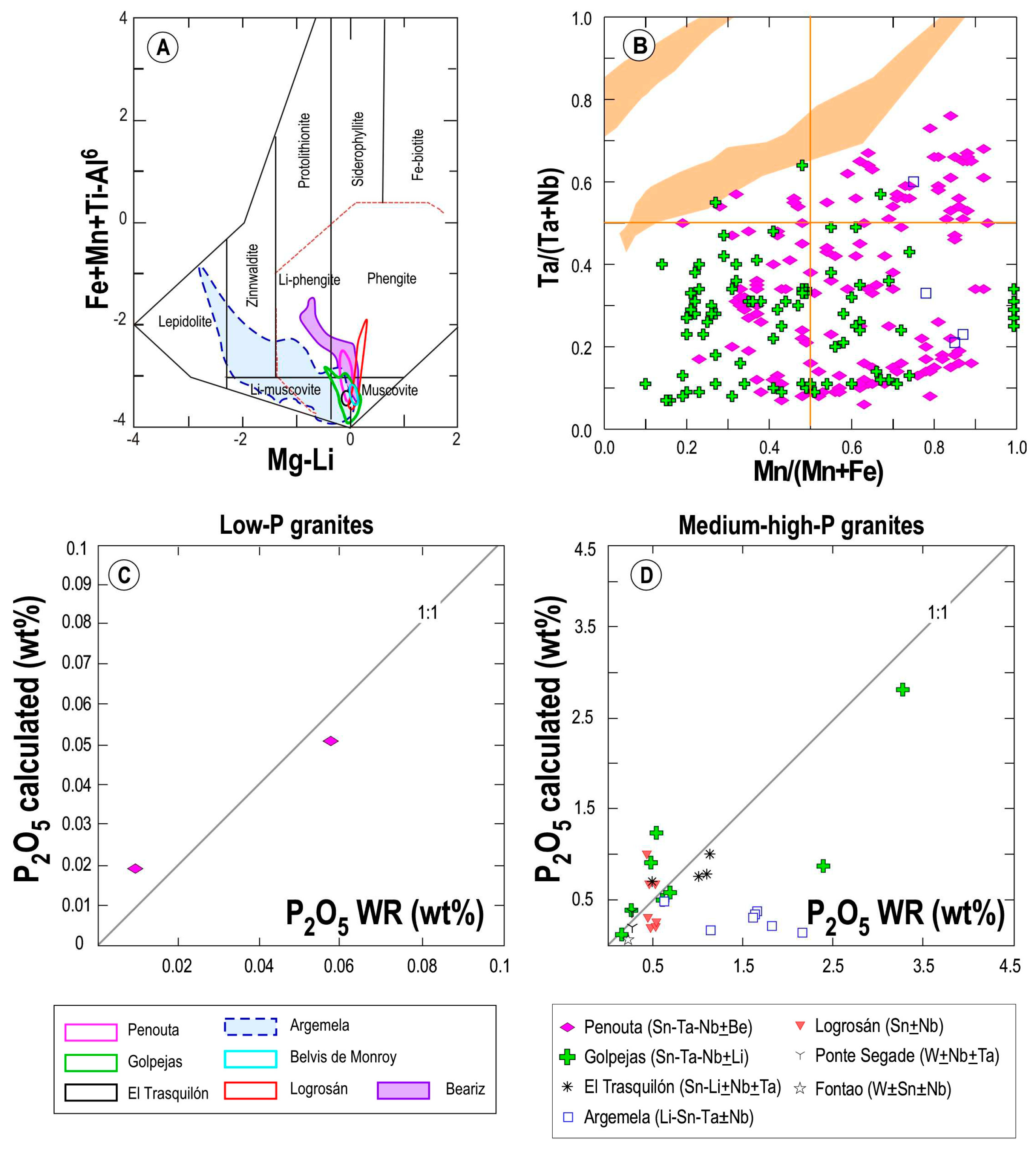
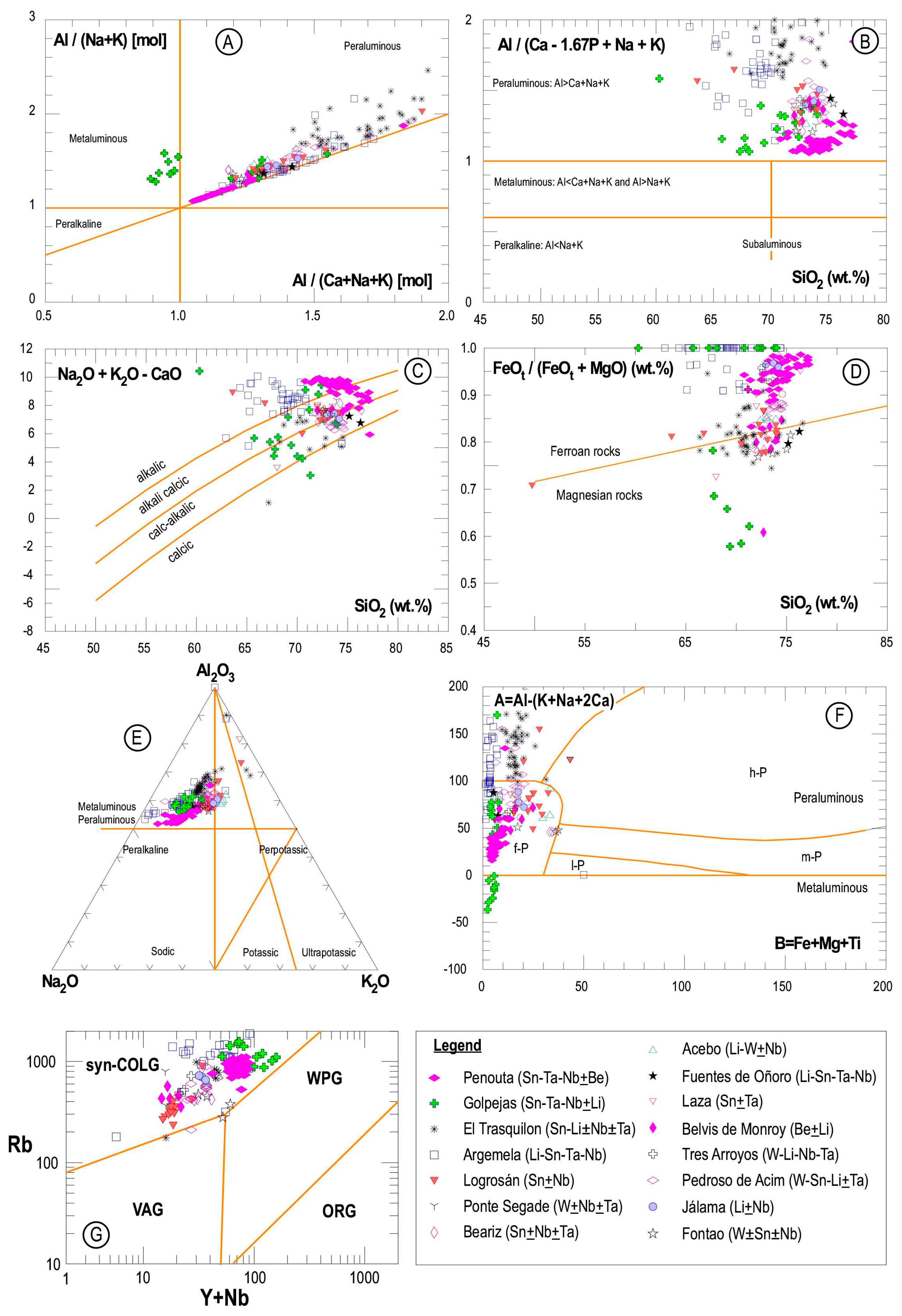
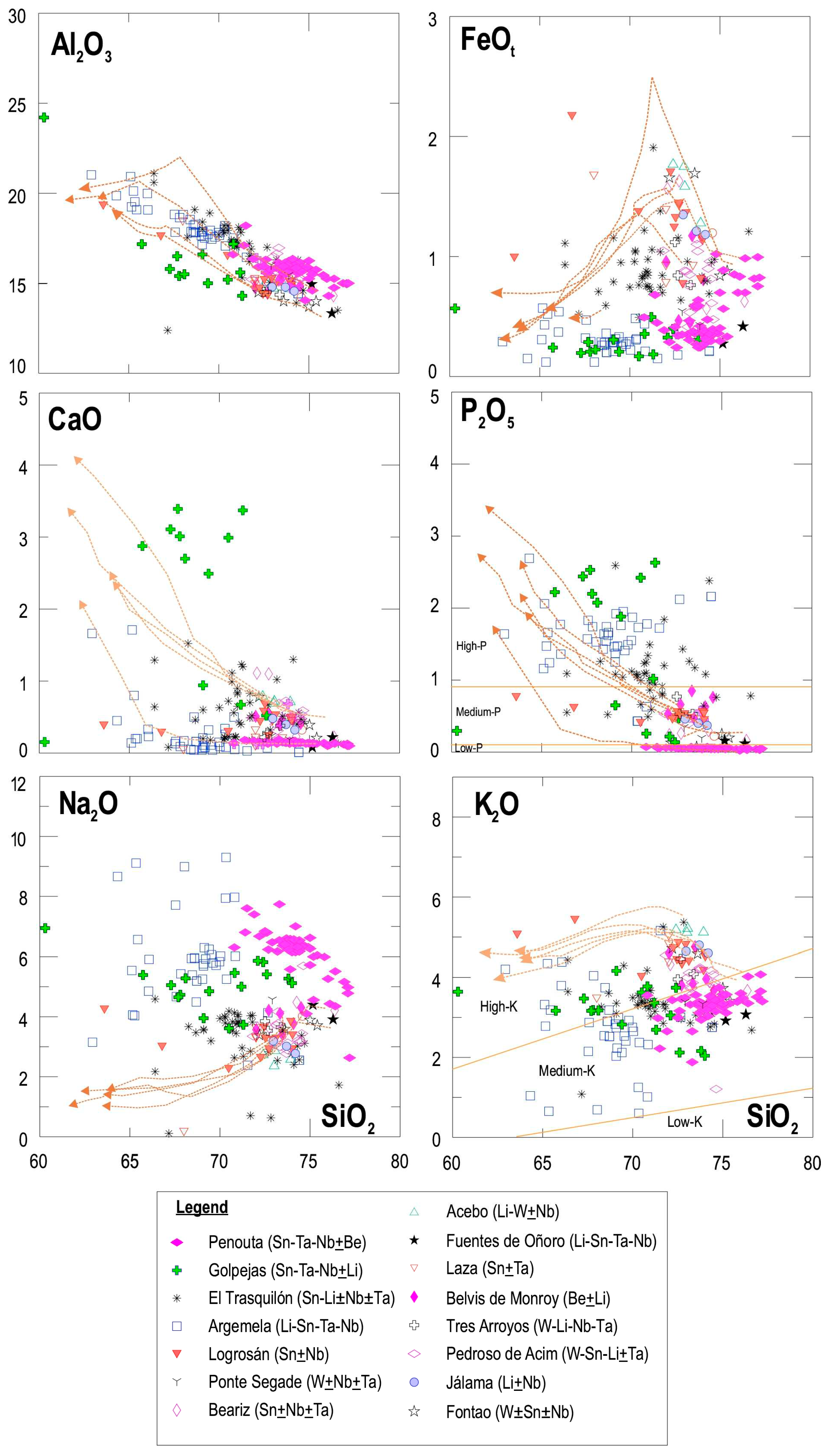
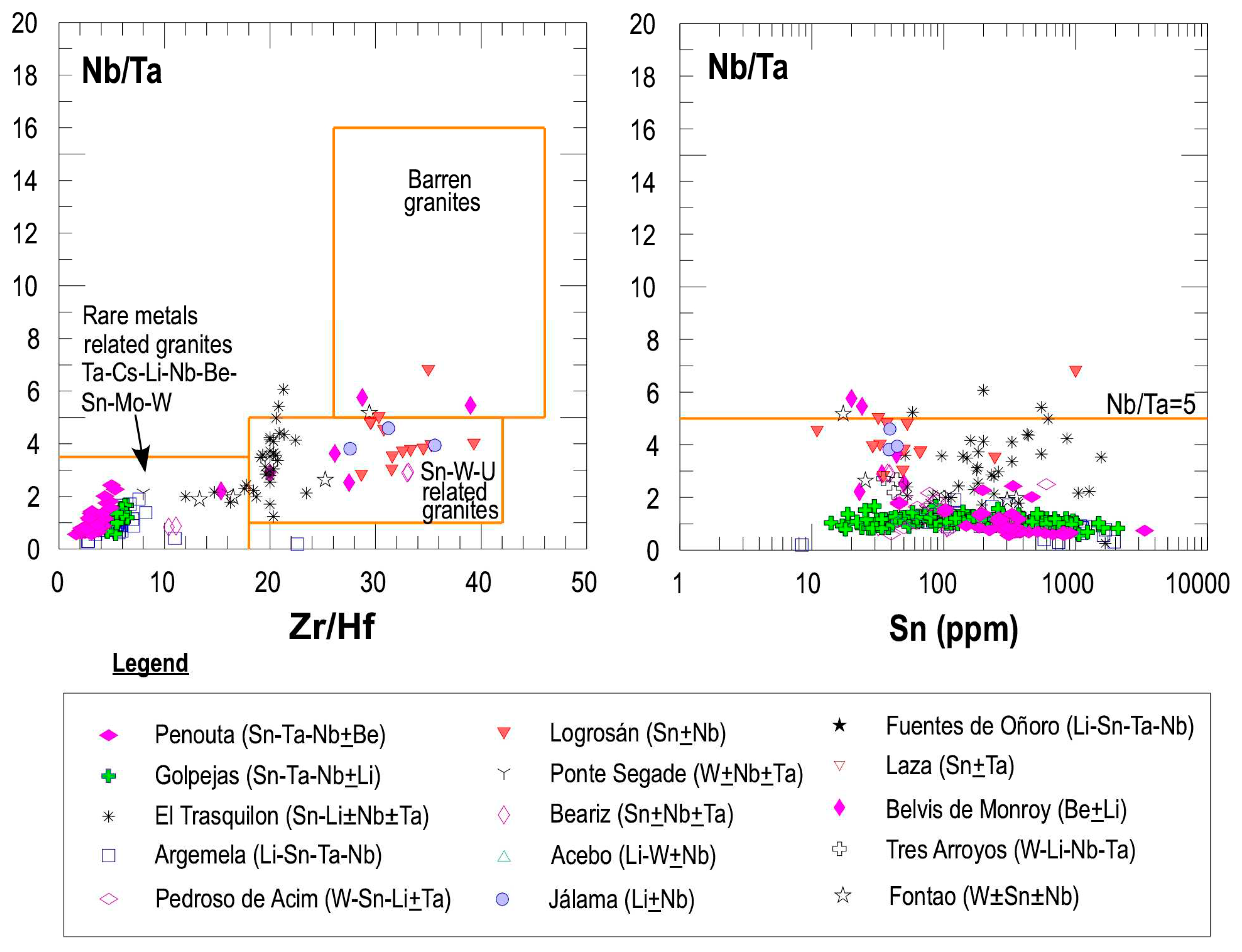
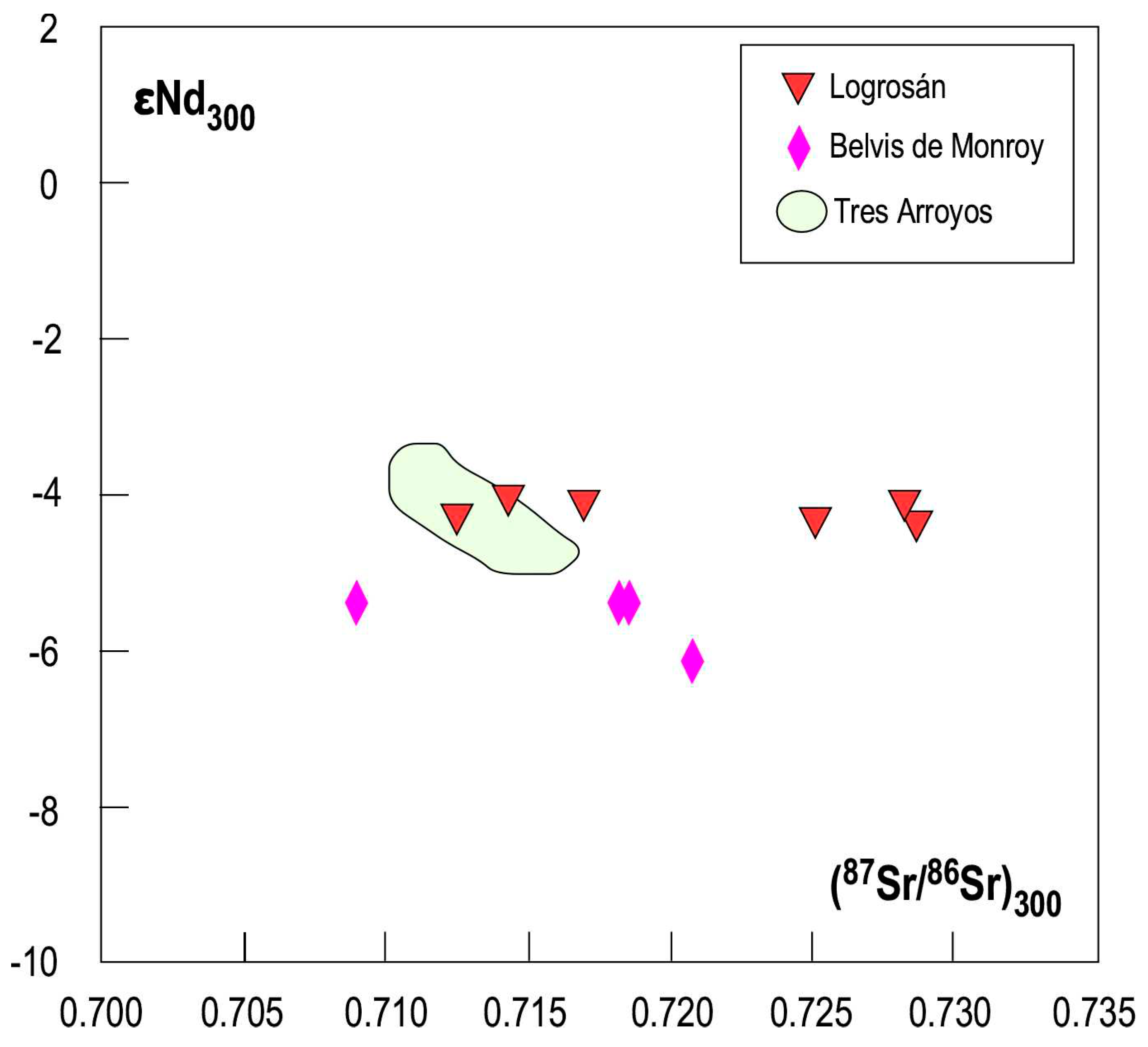
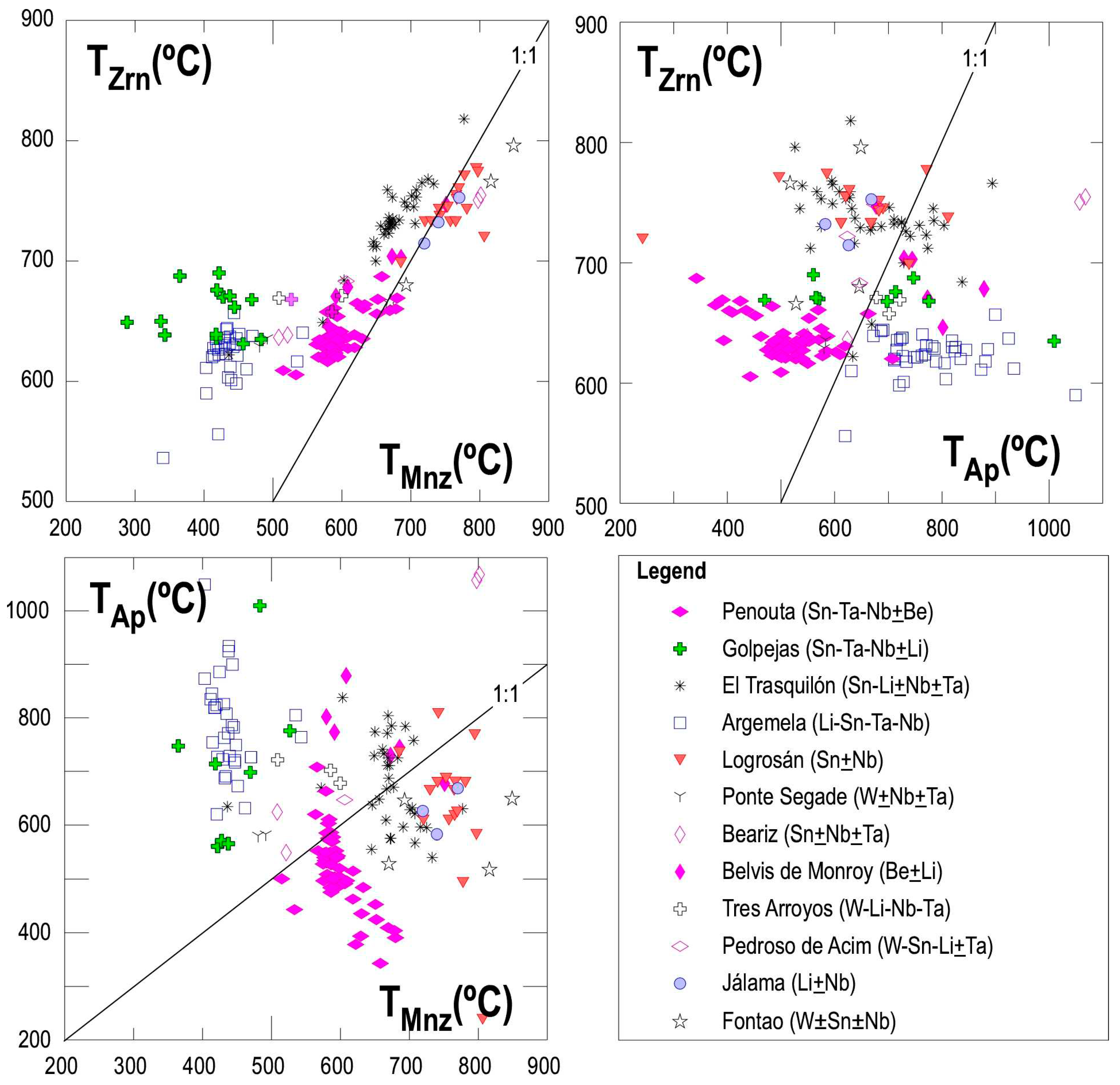
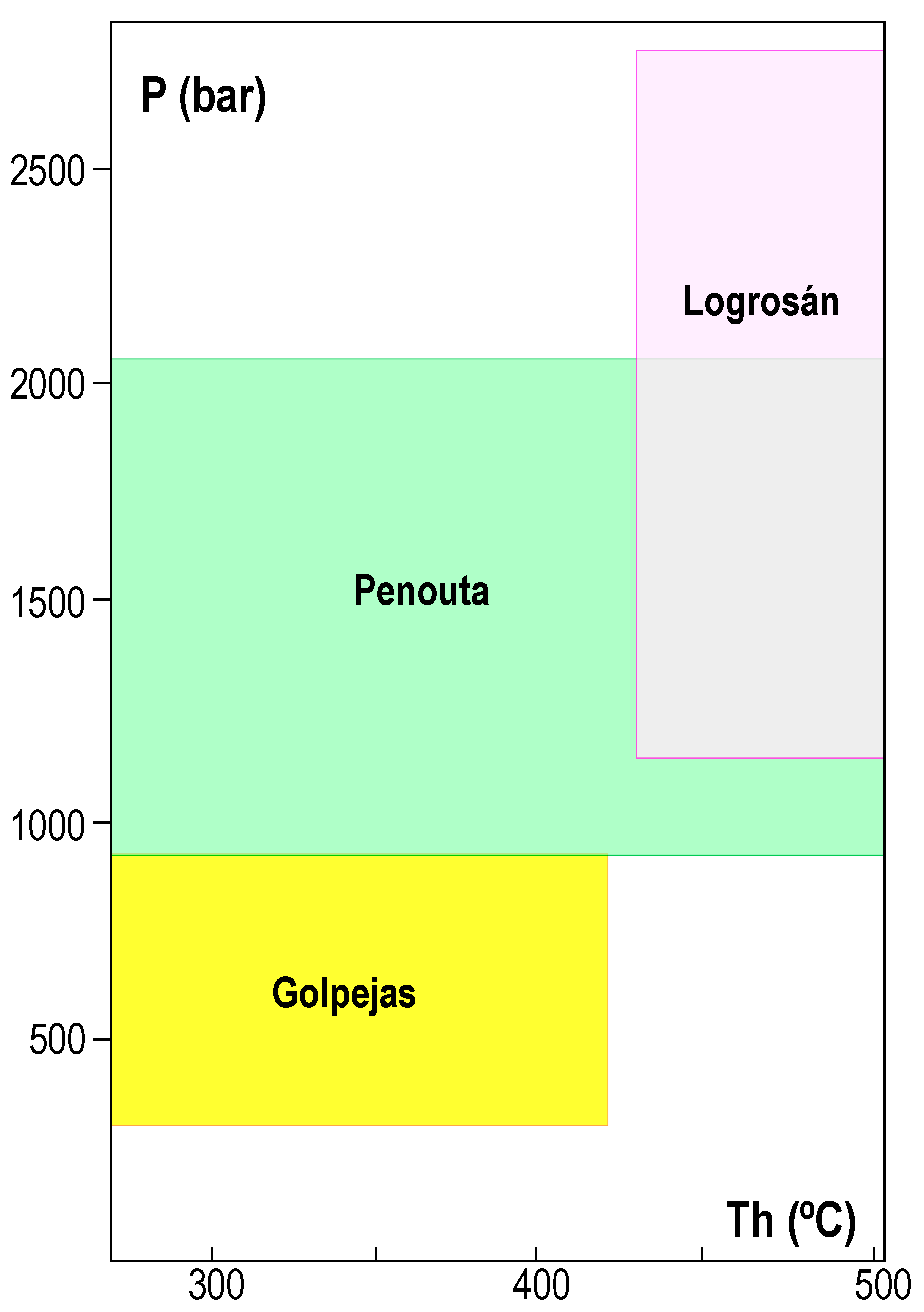
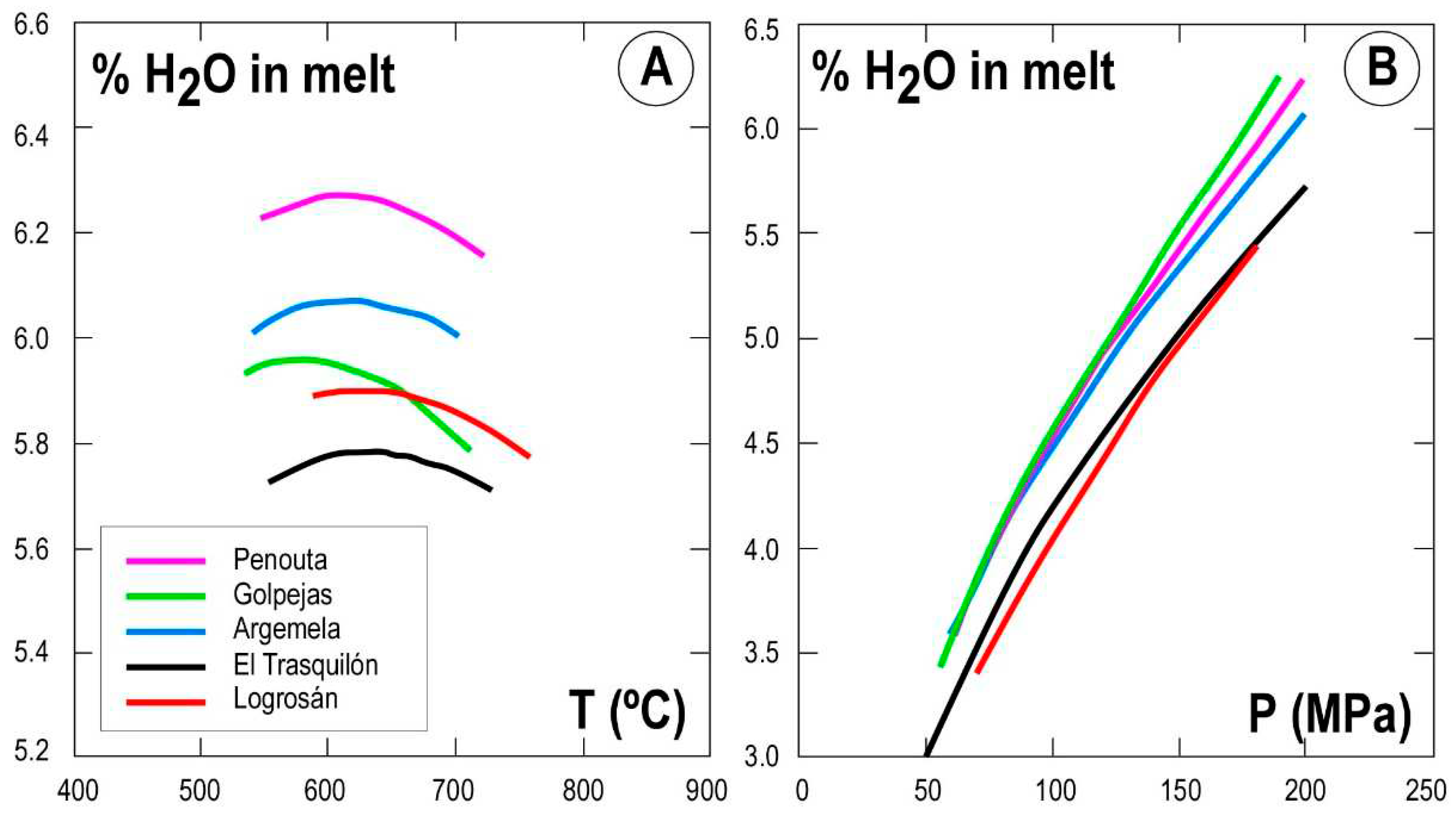
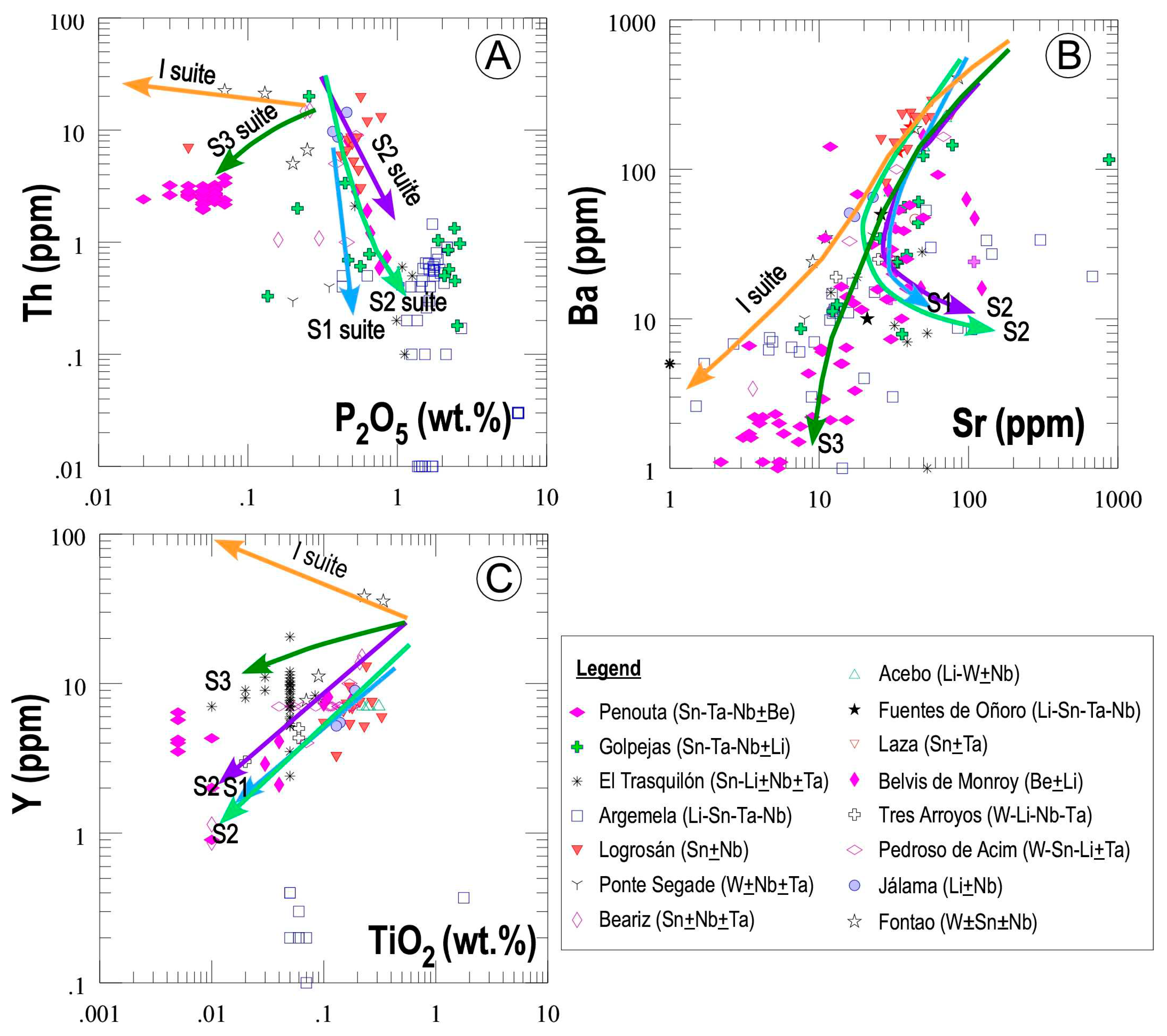
| Granite | Golpejas | Penouta | Argemela | El Trasquilón | Logrosán | ||||||||||
| Value | Max | Av | Std | Max | Av | Std | Max | Av | Std | Max | Av | Std | Max | Av | Std |
| SiO2 (wt.%) | 74 | 69.66 | 3.39 | 77.20 | 74.26 | 1.45 | 74.41 | 69.69 | 5.26 | 76.60 | 71.22 | 2.15 | 74.03 | 70.52 | 6.22 |
| TiO2 | 0.05 | 0.05 | 0.00 | 0.01 | 0.00 | 0.00 | 0.07 | 0.05 | 0.27 | 0.09 | 0.05 | 0.01 | 0.33 | 0.19 | 0.06 |
| Al2O3 | 24.2 | 16.30 | 2.19 | 18.20 | 15.71 | 0.66 | 21.02 | 17.31 | 3.57 | 21.10 | 17.00 | 1.63 | 31.61 | 16.49 | 4.25 |
| FeOt | 0.57 | 0.31 | 0.11 | 1.02 | 0.49 | 0.22 | 0.57 | 0.28 | 0.12 | 1.91 | 0.89 | 0.25 | 2.18 | 1.30 | 0.38 |
| MnO | 0.16 | 0.07 | 0.06 | 0.20 | 0.05 | 0.05 | 0.06 | 0.03 | 0.02 | 0.49 | 0.06 | 0.07 | 0.04 | 0.02 | 0.01 |
| MgO | 0.16 | 0.11 | 0.04 | 0.09 | 0.03 | 0.01 | 0.04 | 0.03 | 0.17 | 0.31 | 0.20 | 0.06 | 0.75 | 0.31 | 0.14 |
| CaO | 3.39 | 1.63 | 1.35 | 0.19 | 0.14 | 0.02 | 1.71 | 0.23 | 0.36 | 1.52 | 0.59 | 0.37 | 0.69 | 0.42 | 0.15 |
| Na2O | 6.94 | 5.07 | 0.82 | 7.74 | 6.10 | 0.90 | 9.30 | 5.46 | 2.02 | 4.59 | 3.23 | 0.97 | 4.28 | 3.10 | 0.66 |
| K2O | 4.16 | 3.14 | 0.61 | 4.07 | 3.30 | 0.36 | 5.16 | 2.56 | 1.12 | 5.37 | 3.37 | 0.65 | 8.50 | 4.87 | 1.03 |
| P2O5 | 2.63 | 1.32 | 0.98 | 0.07 | 0.05 | 0.01 | 2.69 | 1.71 | 0.85 | 2.59 | 1.08 | 0.43 | 0.78 | 0.51 | 0.15 |
| LOI | 2.14 | 1.55 | 0.44 | - | - | - | 4.49 | 1.65 | 0.74 | 3.20 | 2.03 | 0.44 | 5.86 | 1.96 | 1.55 |
| Total | 100.4 | 100.3 | 0.15 | 102 | 100.2 | 1.01 | 100.3 | 98.9 | 0.68 | 101.1 | 99.75 | 0.86 | 99.99 | 98.6 | 0.87 |
| A/CNK | 1.55 | 1.13 | 0.19 | 1.83 | 1.14 | 0.11 | 2.01 | 1.56 | 1.04 | 2.26 | 1.84 | 1.01 | 2.73 | 1.49 | 0.37 |
| A/NK | 1.58 | 1.39 | 0.12 | 1.87 | 1.16 | 0.11 | 2.16 | 1.61 | 1.04 | 2.46 | 2.06 | 1.12 | 2.76 | 1.59 | 0.35 |
| F (ppm) | 15749 | 3249 | 3630 | - | - | - | 12500 | 4875 | 3287 | 5800 | 2457 | 1582 | 5495 | 1002 | 1534 |
| Li | 1084 | 86 | 98 | 129 | 129 | - | 5532 | 1607 | 1634 | 4555 | 318 | 413 | 780 | 132 | 209 |
| Rb | 2184 | 1030 | 282 | 1105 | 892 | 114 | 2448 | 1224 | 613 | 985 | 792 | 87 | 918 | 363 | 156 |
| Cs | 97 | 27.82 | 20.39 | 56.00 | 34.98 | 7.02 | 350 | 89.97 | 99.86 | 81.00 | 81.00 | - | 275 | 70.32 | 66.55 |
| Ba | 145 | 45.10 | 42.95 | 141.50 | 17.43 | 26.18 | 53 | 9.61 | 11.16 | 19.00 | 9.14 | 6.07 | 290 | 200 | 51.72 |
| Sr | 875 | 86.41 | 204.88 | 62.60 | 17.38 | 14.00 | 677 | 42.83 | 113.3 | 90.00 | 37.09 | 24.70 | 77.00 | 44.50 | 13.47 |
| Pb | 18 | 6.03 | 4.51 | - | - | - | 34.50 | 9.68 | 10.12 | 8.00 | 6.43 | 1.40 | 40.00 | 19.81 | 12.42 |
| Cr | 67 | 7.21 | 18.06 | 10.00 | 4.91 | 5.05 | 5.20 | 1.39 | 1.67 | - | - | - | - | - | - |
| Ni | 43 | 12.58 | 11.80 | - | - | - | 8.31 | 0.80 | 1.82 | 16.00 | 6.29 | 5.99 | 20.00 | 16.25 | 8.06 |
| V | 77 | 5.84 | 19.65 | - | - | - | 0.00 | 0.00 | 0.00 | - | - | - | 21.00 | 9.59 | 4.37 |
| Cu | 75.5 | 17.27 | 22.02 | - | - | - | 36.64 | 8.71 | 9.32 | - | - | - | 50.00 | 12.50 | 11.83 |
| Zn | 139 | 64.22 | 23.19 | 0.72 | 0.28 | 0.13 | 134.0 | 45.53 | 39.79 | 116.0 | 89.57 | 20.74 | 100 | 44.24 | 30.88 |
| As | 24.3 | 6.84 | 6.36 | - | - | - | 103.9 | 13.63 | 29.10 | 266.0 | 95.00 | 84.22 | 1470 | 170.50 | 354.6 |
| Sc | - | - | - | - | - | - | 0.22 | 0.01 | 0.04 | - | - | - | 6.00 | 2.44 | 1.71 |
| Sn | 2097 | 296 | 359.4 | 3800 | 521 | 449.4 | 1960 | 686 | 453.2 | 5830 | 257 | 653 | 1000 | 114 | 242.0 |
| Nb | 230 | 115 | 32.1 | 89 | 68 | 9.1 | 91 | 50 | 21.1 | 97 | 35 | 12.5 | 21.3 | 13 | 3.9 |
| Ta | 215 | 105 | 32.1 | 226 | 73 | 38.5 | 161 | 62 | 36.8 | 78.5 | 13 | 11.9 | 5.7 | 3 | 1.1 |
| W | 17.4 | 5.96 | 5.37 | 5.00 | 2.51 | 0.72 | 58.80 | 7.39 | 9.63 | - | - | - | 376 | 95.68 | 119.4 |
| Zr | 39 | 29.67 | 5.09 | 31.00 | 20.21 | 4.52 | 28.60 | 13.64 | 4.10 | 139 | 59.67 | 22.25 | 118 | 74.00 | 19.78 |
| Hf | 7.83 | 5.41 | 1.21 | 8.50 | 6.87 | 0.87 | 5.36 | 2.73 | 1.05 | 6.21 | 2.91 | 0.78 | 3.10 | 2.29 | 0.56 |
| Th | 20 | 2.13 | 4.83 | 3.77 | 2.67 | 0.35 | 1.45 | 0.40 | 0.30 | 2.10 | 0.50 | 0.74 | 19.90 | 8.08 | 4.15 |
| U | 37.9 | 8.65 | 10.15 | 15.80 | 10.62 | 2.66 | 39.00 | 8.36 | 5.87 | 50.00 | 34.00 | 13.01 | 15.50 | 9.29 | 2.50 |
| Ga | 329 | 37.31 | 26.37 | 44.70 | 35.50 | 2.84 | 68.00 | 33.51 | 11.30 | 53.00 | 41.14 | 6.41 | 91.00 | 27.81 | 17.44 |
| Be | 103 | 44.76 | 33.41 | 125 | 125 | - | 385 | 95.44 | 84.30 | - | - | - | 23.00 | 11.00 | 6.95 |
| Ge | 8.46 | 4.05 | 1.58 | - | - | - | 5.54 | 2.13 | 2.31 | - | - | - | 3.80 | 1.98 | 1.14 |
| Y | 9.07 | 0.90 | 2.28 | 9.80 | 3.34 | 1.43 | 1.35 | 0.18 | 0.23 | 20.50 | 8.52 | 3.06 | 13.10 | 6.66 | 2.34 |
| La | 0.41 | 0.16 | 0.13 | 1.80 | 0.74 | 0.31 | 0.61 | 0.17 | 0.16 | 9.98 | 3.95 | 1.58 | 21.80 | 13.13 | 4.19 |
| Ce | 0.82 | 0.30 | 0.26 | 4.70 | 1.94 | 0.83 | 3.30 | 0.28 | 0.51 | 22.50 | 8.82 | 3.52 | 50.20 | 29.48 | 9.66 |
| Pr | 0.1 | 0.04 | 0.03 | - | - | - | 0.21 | 0.02 | 0.03 | 2.86 | 1.10 | 0.44 | 6.42 | 3.04 | 1.92 |
| Nd | 0.6 | 0.23 | 0.19 | 3.10 | 1.09 | 0.53 | 1.32 | 0.08 | 0.20 | 11.77 | 4.56 | 1.81 | 25.80 | 13.39 | 4.95 |
| Sm | 0.77 | 0.09 | 0.21 | 4.23 | 1.86 | 0.77 | 0.45 | 0.03 | 0.07 | 4.52 | 1.69 | 0.68 | 5.18 | 3.01 | 1.01 |
| Eu | 0.3 | 0.05 | 0.10 | 0.11 | 0.02 | 0.03 | 0.31 | 0.01 | 0.05 | 0.15 | 0.03 | 0.03 | 0.58 | 0.32 | 0.11 |
| Gd | 2.19 | 0.21 | 0.60 | 8.01 | 3.89 | 1.48 | 0.53 | 0.03 | 0.08 | 5.20 | 2.03 | 0.81 | 3.64 | 2.30 | 0.64 |
| Tb | 0.36 | 0.09 | 0.10 | 1.46 | 0.76 | 0.25 | 0.06 | 0.00 | 0.01 | 1.05 | 0.41 | 0.16 | 0.54 | 0.34 | 0.09 |
| Dy | 1.76 | 0.24 | 0.52 | 4.19 | 1.57 | 0.64 | 0.27 | 0.02 | 0.05 | 4.99 | 2.00 | 0.77 | 2.22 | 1.57 | 0.39 |
| Ho | 0.31 | 0.05 | 0.10 | 0.12 | 0.04 | 0.02 | 0.04 | 0.00 | 0.01 | 0.63 | 0.25 | 0.10 | 0.34 | 0.23 | 0.06 |
| Er | 0.76 | 0.09 | 0.20 | 0.17 | 0.02 | 0.03 | 0.08 | 0.02 | 0.03 | 1.31 | 0.53 | 0.20 | 0.86 | 0.55 | 0.15 |
| Tm | 0.09 | 0.02 | 0.03 | 0.01 | - | - | 0.01 | 0.00 | 0.00 | 0.14 | 0.06 | 0.02 | 0.12 | 0.08 | 0.02 |
| Yb | 0.45 | 0.11 | 0.15 | 0.18 | 0.03 | 0.04 | 3.00 | 0.09 | 0.46 | 0.85 | 0.35 | 0.13 | 0.71 | 0.47 | 0.12 |
| Lu | 0.06 | 0.01 | 0.02 | 0.02 | 0.00 | 0.01 | 0.01 | 0.00 | 0.00 | 0.10 | 0.05 | 0.02 | 0.11 | 0.07 | 0.02 |
| ∑REE | 7.79 | 1.40 | 1.96 | 26.36 | 11.98 | 4.56 | 5.16 | 0.76 | 1.00 | 65.93 | 25.82 | 10.14 | 117.0 | 67.96 | 22.28 |
| T Zrn (°C) | 690 | 657 | 19.10 | 687 | 636 | 16.98 | 657 | 621 | 21.56 | 818 | 739 | 28.28 | 778 | 745 | 20.51 |
| T Mnz | 527 | 417 | 61.59 | 680 | 597 | 31.87 | 543 | 354 | 174.3 | 777 | 676 | 36.70 | 806 | 760 | 31.06 |
| T Ap | 1010 | 556 | 310.1 | 708 | 513 | 70.27 | 1049 | 759 | 145.8 | 894 | 672 | 89.42 | 811 | 637 | 129.1 |
Disclaimer/Publisher’s Note: The statements, opinions and data contained in all publications are solely those of the individual author(s) and contributor(s) and not of MDPI and/or the editor(s). MDPI and/or the editor(s) disclaim responsibility for any injury to people or property resulting from any ideas, methods, instructions or products referred to in the content. |
© 2024 by the authors. Licensee MDPI, Basel, Switzerland. This article is an open access article distributed under the terms and conditions of the Creative Commons Attribution (CC BY) license (http://creativecommons.org/licenses/by/4.0/).


